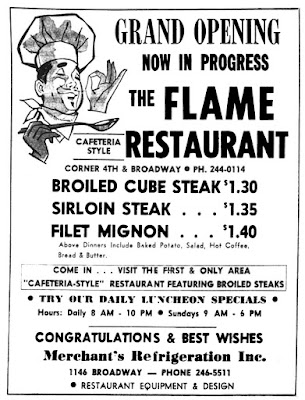Back when the
Journal was still a Lorain-based newspaper, the publication often featured articles that profiled the movers and shakers whose investment in the city contributed to its growth, success and quality of life.
Here's one of those articles, written by Journal Staff Writer Bob Cotleur. It profiles the three Gary Brothers and their various businesses. (I’ve posted so many of ads for Si Gary Dodge and Gary Motors Sales on this blog that it seems appropriate that I highlight the men behind the companies.)
The article is presented as it appeared in the Sunday Journal of January 19, 1969.
****
The Gary Brothers Found Opportunity in Lorain
By BOB COTLEUR
Staff Writer
THERE IS A LORAIN not everyone knows. It is a Lorain of opportunity, a city where anyone can live, flourish, excel.
Three brothers found it a land untouched by rigid cliques and power groups, a land “where everybody’s a minority group,” a land where hard work and long hours paid off in success with an ancient wish:
“From rags to riches.”
The three are the Gary brothers, Dave, 63, Simon, 60, and Frank, 58.
You can see their business signs along the main drag on Broadway. Si Gary Dodge. And Gary Motors, Inc. (Frank). And Shiff-Gary, Inc. (Dave).
Many area people bought cars from a Gary, rented or leased a Gary-built building. Some 250 people bought Gary-built homes from a corporation called Land Development, Inc.
Other Gary owned corporations include Wedgewood Estates, South Shore Development Company, Fransi Corp., and the Advance Tool & Die Company in Columbus.
WHAT FEW PEOPLE in town realize is that the Gary brothers have helped “hundreds of people to own homes they otherwise couldn’t afford.” The brothers always had a tremendous desire to help people down on their luck, but they tried to help those they thought honestly needed help and were worthy of it.
One typical family went to Dave Gary. He bought the mortgage, got it re-financed and kept the family going until they got back on their feet. Some time later the woman of the home came to see Dave and told her child to repeat his evening prayers aloud.
“The child ended with, ‘And God Bless Mr. Gary’.”
The corporations are off-shoots of Gary Enterprises Inc. which the brothers say has accounted for $10 million worth of construction “mostly in Lorain” during the 30 years they’ve been here.
You’ve been in a Gary-built building at one time or another. Among them are the present Driscol Music Co., Internal Revenue Service building, AAMCO, Midas Muffler, Lake Terrace Apartments, Dalton of America.
When Dave Gary first arrived in Lorain in 1931 he says “I had to borrow lunch money to eat.”
Dave is the pathfinder, the head of the clan. As a youth he found a way to get in the movies by selling five newspapers at a penny profit each. They were the only newspapers he ever sold.
At 13, he went into the coal mines. “It only lasted until mother found out two months later. She got me out of there,” he said.
At 18 Dave left the family home in Philipsburg, Pa., and came to Cleveland for the bigger job opportunities. His brothers followed in a few years and eventually the whole family, three boys, four girls and parents, made Cleveland their home.
DAVE GARY WAS managing a chain of shoe stores when the Depression hit and the chain went under. His first job in Lorain shortly after, was managing the Factory Shoe Store on Broadway.
He took the job with just 75 cents to his name.
A year later he’d saved $150 and used it to begin Advance Motor Sales, a used car lot.
But he knew more about shoes.
“A customer came back one day complaining about noisy tappers,” Dave remembered. “I was so dumb I told him it wasn’t tappets making the noise, it was just a noisy rod bearing.”
Tappets are easily and inexpensively adjusted. Rod bearings are deep in the heart of an engine and if one makes a lot of noise it means the engine is ready to blow up.
Dave retired from the auto business three years ago, couldn’t stand the inactivity and came back into the real estate and mortgage loan field.
Today he is quiet, conservative, a pipe-smoker who thinks while he puffs.
SI IS SHORT for Simon. He came to Lorain in 1936 already in debt. “If I was just broke, I’d have been in good shape,” he said.
He started working for Dave. In time he got into new car sales and had the incredible bad luck of choosing one loser after another.
“First I sold Kaiser-Frazers. They went out of business. Then it was Hudsons. They went under. Things looked better when I took on Ford’s Edsel, and you know what happened.”
But he was a huge success with Edsel. He sold “about 200 a year. I liked the car. It was a good, sound car. But they (Ford Motor Co.) didn’t need it. Why a good ’59 model today brings anywhere from $159 to $1,500. It’s a collector’s item.”
Despite Ford’s desires to get Si Gary into a Mercury franchise, he went with Dodge. With Dodge, Si’s luck is changing.
Frank the youngest brother, was married in 1930 in the lovely month of June. “I was fired from my job in July,” he said, “so I sold candied apples and ice cream bars for a year.”
He had a good thing going until one competitor suddenly swooped his business away. Frank learned why. “It was still prohibition and this guy had little bottles of booze tucked under his ice cream cart.”
Frank got to Lorain in 1939 and like Si, took a new car dealership while Dave went to work for Dave. But Frank and Si stayed with used cars.
THE BROTHERS prospered. They joined in community life. Today they belong to the Masonic Lodge, to the Agudath B’nai Israel Synagogue and its B’nai B’rith men’s group, and have actively participated in United Appeal or Community Chest work and fund raising for the American Red Cross.
Financially speaking the brothers are equal partners in everything. “We’ve been in business 30 years,” Si said, “and never had an argument. We’re a close knit partnership and never have, over all those years, even checked each others books.”
If one brother needs $10,000 he takes it, but the others don’t take out an equal share. Each knows the vital difference between need and desire.
“We’ve agreed,” Frank laughed, “but we married three different women and they might not agree. However they all know they can’t affect what the three brothers do.”
Potential financial projects are something else again. As Dave put it, it works like this:
“Si is the gambler. He’ll gamble on anything. Frank is the conservative. I put them together.”
“DAVE IS THE typical older brother,” the other two point out. “He loves to build. He’s the brother we look up to and go to for advice. His philosophy is homespun, but we agree with it.”
Frank is the trio’s intellectual. The others say he wanted to be a doctor, but there weren’t enough funds at the time.
Si is the magnet, the Pied Piper with children. “I suppose because he hasn’t any of his own,” Dave said. Dave, who married the former Ruth Levine of Cleveland, has two sons. Eugen, 38, with Ohio Motors, and Robert, 27, a prosecutor with the Justice Department in Washington.
Frank, who married the former Hilda Kess of Cleveland, has a daughter Ellen Jean, 35, now Mrs. Robert Bartick of Lorain, and James, 27, a stockholder in Cleveland.
SI MARRIED another Clevelander, the former Sadie Lieberman. He and his brother Frank are the Gary golfers and Si has fired three separate holes-in-one, which might lead some to believe he’s really Gary Player.
Dave prefers being “a homebody. I’ve been fairly active in civic and fund-raising affairs because I can still remember when I was poor.”
How would the three advise someone staring in business today in Lorain?
Si: “All it takes is plenty of hard work, long hours.”
Frank: “… but with some integrity.”
Dave: “… and try to put yourself in the other guy’s shoes.”




















































